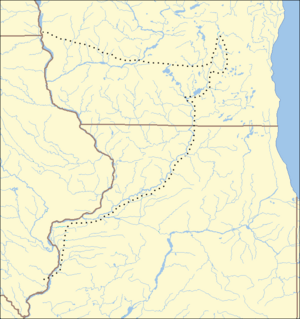Battle of Stillman's Run facts for kids
Quick facts for kids Battle of Stillman's Run |
|||||||
|---|---|---|---|---|---|---|---|
| Part of the Black Hawk War | |||||||
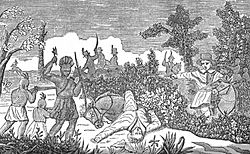 Battle of Stillman's Run, Benjamin Drake |
|||||||
|
|||||||
| Belligerents | |||||||
| British Band | |||||||
| Commanders and leaders | |||||||
| Black Hawk | |||||||
| Strength | |||||||
| 40-50 | 275 | ||||||
| Casualties and losses | |||||||
| 3-5 killed | 12 killed | ||||||
The Battle of Stillman's Run happened in Illinois on May 14, 1832. It's also known as the Battle of Sycamore Creek or Old Man's Creek. This battle was the first major fight of the Black Hawk War.
The battle got its name because Major Isaiah Stillman and his group of 275 Illinois militia soldiers ran away in a panic. They were attacked by warriors from Black Hawk's group, known as the British Band. This group included Sauk and Fox people, along with their families.
Black Hawk's group had crossed the Mississippi River from Iowa into Illinois. They wanted to resettle in Illinois. The militia chased a small group of Sauk scouts back to Black Hawk's main camp. This happened after Black Hawk's messengers tried to talk and make peace, but it didn't work.
During the fight, 12 militia soldiers were killed while trying to defend themselves on a small hill. The rest of the militia ran all the way back to Dixon's Ferry. In 1901, people built a monument in Stillman Valley, Illinois to remember the battle. Some reports say that Abraham Lincoln, who was a militia volunteer, helped bury the dead soldiers.
Contents
Why the Battle Happened
Black Hawk, a leader of the Sauk people, believed that a treaty signed in 1804 was not fair. This treaty, called the Treaty of St. Louis (1804), gave away land that included his birthplace to the United States.
Starting in 1830, Black Hawk led his people across the Mississippi River from Iowa into Illinois several times. Each time, he was convinced to go back west without any fighting. But in April 1832, he tried again. He hoped that other Native American tribes and even the British in Canada would help him.
He moved his "British Band" into Illinois. However, he didn't find the allies he expected. He then tried to go back to Iowa. But events unfolded that led to the Battle of Stillman's Run. After this battle, more fights happened. The state militias from Wisconsin and Illinois were called to find Black Hawk's group. This conflict became known as the Black Hawk War.
| Map of Black Hawk War sites Symbols are wikilinked to article |
On April 5, 1832, Black Hawk and about 1,000 people crossed the Mississippi River into Illinois. About half of them were warriors, and the rest were women, children, and older people. The group included Sauk, Fox, some Potawatomi, and some Kickapoo people. Some members of the Ho-Chunk nation also supported Black Hawk.
People disagree about why Black Hawk crossed into Illinois. For a long time, it was thought he wanted to get back lost land and maybe unite Native American tribes against white settlers. However, some historians now think he might have just been trying to resettle near the Ho-Chunk people. The large number of non-fighters in his group supports this idea.
Black Hawk led his group along the Rock River into Illinois. The Governor of Illinois, John Reynolds, saw Black Hawk's return as an invasion. He quickly called up the militia. General Henry Atkinson was in charge of the military effort. Black Hawk called him "White Beaver."
Before the Battle
General Atkinson was not told about Governor Reynolds' decision to send Major Isaiah Stillman's militia to Old Man's Creek. Governor Reynolds had ordered Stillman to find Black Hawk and make him surrender. Stillman followed these orders and moved his troops.
Stillman's group was not officially under General Samuel Whiteside's command. This meant they reported directly to Governor Reynolds. Whiteside's own militia soldiers were getting impatient. Many of them wanted to go home while they waited for Atkinson's regular army to arrive.
Black Hawk's big plan for British help and a Native American alliance had fallen apart. No major groups came to help him. His followers started to get hungry. Black Hawk realized his only choice was to go back across the Mississippi River. When he saw the U.S. militia camp about eight miles away, Black Hawk sent messengers to try and make peace. They were told to wave a white flag at the militia.
The Battle Begins
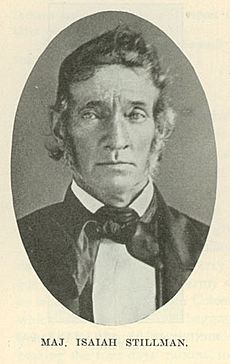
On May 14, 1832, 275 militia soldiers led by Majors Isaiah Stillman and David Bailey were camped near Old Man's Creek. This was close to where the creek met the Rock River. Their camp was about three miles east of the Rock River, near today's Stillman Valley, Illinois. It was seven miles south of Black Hawk's camp. The militia and their leaders probably didn't know how close they were to Black Hawk's group.
Black Hawk learned about Stillman's presence from the local Potawatomi people. He sent three messengers to the militia camp with a white flag, hoping to talk and make peace. The soldiers were already suspicious. They took the three messengers to their camp. During this time, the militia saw several of Black Hawk's scouts watching from the nearby hills.
Once the scouts were seen, soldiers shot at the three messengers, killing one. The other two ran back toward their camp. The militia chased the scouts, killing several of them. The surviving scouts reached Black Hawk's camp before the militia. They told Black Hawk what had happened.
At the camp, Black Hawk's warriors quickly formed a line to defend themselves. The militia soldiers, still chasing the scouts, ran right into Black Hawk's main force. Black Hawk and his warriors were hidden and surprised the chasing soldiers. The militia thought thousands of Sauk and Fox warriors were attacking them. They panicked and ran all the way back to Dixon's Ferry.
No one knows exactly where Stillman was during this part of the battle. His later report in a newspaper didn't say where he was. He only mentioned that his only order was to retreat. Stillman's report was later called "fanciful," meaning it might not have been completely true.
Twelve of Stillman's militia soldiers were killed in the chaos. A group of volunteers led by Captain John Giles Adams tried to make a stand on a hill south of the main militia camp. These men fought by moonlight while the rest of the militia ran back to Dixon. All 12 men, including Captain Adams, were killed. Some say Adams might have been killed by his own men as he tried to get them to fight.
We don't know exactly how many Sauk and Fox warriors were killed. A militia group sent to find the 53 missing militia men didn't find any dead Sauk warriors. Black Hawk said that three to five of his warriors were killed.
Abraham Lincoln's Connection
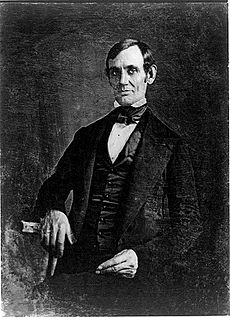
The details about Abraham Lincoln's service during the Black Hawk War have been debated. Lincoln was connected to two major battle sites, including Stillman's Run, after the fighting. Many sources say that on June 26, 1832, the morning after the Second Battle of Kellogg's Grove, soldiers from Captain Jacob M. Early's company arrived to help bury the dead. Lincoln was one of these soldiers and helped with the burials.
Lincoln later spoke about what he saw. This quote has been linked to both the battle at Kellogg's Grove and the fight at Stillman's Run:
I remember just how those men looked as we rode up the little hill where their camp was. The red light of the morning sun was streaming upon them as they lay head towards us on the ground. And every man had a round red spot on top of his head, about as big as a dollar where the redskins had taken his scalp. It was frightful, but it was grotesque, and the red sunlight seemed to paint everything all over. I remember one man had on buckskin breeches.
Lincoln's quote was in two famous biographies about him. In 2006, author Scott Dyer wrote that General Whiteside's men, including Captain Lincoln, "paraded" the area the morning after the battle. They buried the dead from Stillman's Run. They tried to get the Sauk to come out and fight, but it didn't work. Then they went back to Dixon's Ferry.
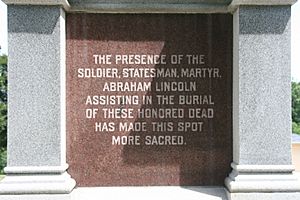
In 1848, Lincoln gave a speech to the U.S. Congress. He talked about his service in the Black Hawk War and mentioned Stillman's Run by name:
By the way Mr. Speaker, did you know that I am a military hero? Yes sir, in the days of the Black Hawk War I fought, bled and came away . . . I was not at Stillman's defeat, but I was about as near it as Cass was Hull's surrender, and, like him, I saw the place very soon afterwards.
The monument in Stillman Valley, built in 1901 to remember the battle, mentions Lincoln. It says, "The presence of soldier, statesman, martyr, Abraham Lincoln assisting in the burial of these honored dead has made this spot more sacred." Other sources say that General Whiteside originally buried the dead in a shared grave on a ridge south of the battlefield. This grave was marked with a simple wooden memorial. These sources do not mention Lincoln.
What Happened Next
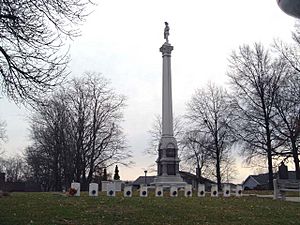
After the fight at Stillman Valley, newspapers reported that 2,000 "bloodthirsty warriors were sweeping all Northern Illinois." This caused a lot of fear in the area. After midnight on May 15, soldiers from Stillman's group started arriving back at Dixon's Ferry. They were wide-eyed and scared, telling stories of a terrible slaughter. Right after the battle, 53 militia men were missing. Later, officials found that most of these men had simply gone home without stopping at Dixon's Ferry.
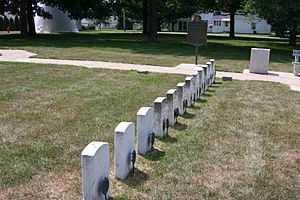
After this first fight, Black Hawk led many of the non-fighters in his group to the Michigan Territory. On May 19, the militia traveled up the Rock River, following Black Hawk and his group. Several smaller fights and attacks happened over the next month in northern Illinois and southern Wisconsin. The militia then gained back public trust after battles at Bloody Lake and Waddams Grove.
Critics of the Illinois Militia, mostly from the Regular Army, criticized their behavior at Stillman's Run. They started calling the battle at Old Man's Creek the Battle of Stillman's Run. This was because Stillman seemed to have run away with the panicked militia.
The fighting in the Black Hawk War began at Stillman's Run. Black Hawk and his British Band were surprised by their victory. Black Hawk worried that the white militia and their allies would seek revenge. Black Hawk led his hungry group away from General Atkinson's chasing army. The chase went as far as today's Madison, Wisconsin. It ended at the Battle of Bad Axe, where the militia and their allies attacked a weakened group, which by then was mostly women and children.
The bodies of the soldiers at Stillman's Run were first buried in a common grave. But who buried them is still a question. A memorial, built in 1901, stands near their marked graves today. The monument and battle site are listed on the U.S. National Register of Historic Places. They are near Illinois Route 72, a block west of today's Stillman Creek.
Images for kids


